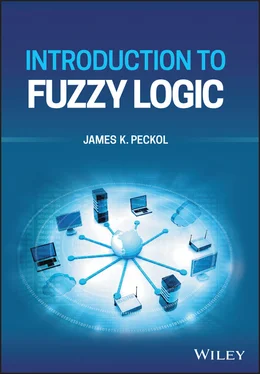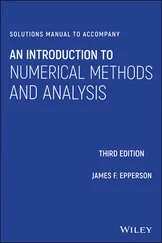James K. Peckol - Introduction to Fuzzy Logic
Здесь есть возможность читать онлайн «James K. Peckol - Introduction to Fuzzy Logic» — ознакомительный отрывок электронной книги совершенно бесплатно, а после прочтения отрывка купить полную версию. В некоторых случаях можно слушать аудио, скачать через торрент в формате fb2 и присутствует краткое содержание. Жанр: unrecognised, на английском языке. Описание произведения, (предисловие) а так же отзывы посетителей доступны на портале библиотеки ЛибКат.
- Название:Introduction to Fuzzy Logic
- Автор:
- Жанр:
- Год:неизвестен
- ISBN:нет данных
- Рейтинг книги:4 / 5. Голосов: 1
-
Избранное:Добавить в избранное
- Отзывы:
-
Ваша оценка:
- 80
- 1
- 2
- 3
- 4
- 5
Introduction to Fuzzy Logic: краткое содержание, описание и аннотация
Предлагаем к чтению аннотацию, описание, краткое содержание или предисловие (зависит от того, что написал сам автор книги «Introduction to Fuzzy Logic»). Если вы не нашли необходимую информацию о книге — напишите в комментариях, мы постараемся отыскать её.
Learn more about the history, foundations, and applications of fuzzy logic in this comprehensive resource by an academic leader Introduction to Fuzzy Logic
Introduction to Fuzzy Logic
Introduction to Fuzzy Logic
Introduction to Fuzzy Logic — читать онлайн ознакомительный отрывок
Ниже представлен текст книги, разбитый по страницам. Система сохранения места последней прочитанной страницы, позволяет с удобством читать онлайн бесплатно книгу «Introduction to Fuzzy Logic», без необходимости каждый раз заново искать на чём Вы остановились. Поставьте закладку, и сможете в любой момент перейти на страницу, на которой закончили чтение.
Интервал:
Закладка:
Appendix A introduces the traditional product development life cycle and stresses the need to thoroughly understand both the operating environment and the system being designed. Further stressed is the difference between a requirements specification and a design specification . Design is only one element of product development. Each design must also be thoroughly tested to confirm and ensure that it meets specified requirements and national and international standards within its operating environment.
Appendix B introduces and provides an overview of the Unified Modeling Language and associated diagrams. The major static diagrams and the utility of each are presented and discussed. Of particular importance are the class and use case diagrams. The need for dynamic modeling is also presented. In addition, important test considerations are introduced.
This appendix also restresses the need for serious system test and the test process. It also provides a brief outline and summary of the key elements and components of a design that potentially can cause (serious) problems during operation and therefore should be considered and closely and carefully examined during the test process.
The Audience
The book is intended for students with a broad range of background and experience and also serves as a reference text for those working in the fields of electrical engineering and computer science. The core audience should have at least one quarter to one semester of study in Boolean algebra and crisp logic design, facility with a high‐level programming language such as C, C++, or Java, and some knowledge of logic devices and operating systems, and should be an upper‐level junior or senior or lower‐level graduate student. Some background in formal system design, test, embedded systems, and analog fields would also be helpful.
Notes to the Instructor
This book can be a valuable tool for students in the traditional undergraduate electrical engineering, computer engineering, or computer science programs as well as for practicing engineers who also wish to review the basic concepts in these programs. Here, students may study the essential aspects of the development of contemporary fuzzy, neural, and approximate reasoning systems.
Students are also given a solid presentation of hardware and software architecture fundamentals, a good introduction to the design process and the formal methods used therein (including safety, security, and reliability). They are also given a comprehensive presentation of the interface to local and distributed external world devices and guidance on how to debug and test their designs.
Key to the presentation is a substantial number of worked examples illustrating fundamental ideas as well as how some of the subtleties in application go beyond basic concepts. Each chapter opens with a list of Things to Look For that highlights the more important material in the chapter and concludes with review questions and thought questions.
The review questions are based directly on material covered in the chapter and mirror and expand on the Things to Look For list. The questions provide students a self‐assessment of their understanding and recall of the material covered. Though based on the material covered in the chapter, the thought questions extend the concepts as well as provide a forum in which students can explore, discuss, and synthesize new ideas based on those concepts with colleagues.
The text is written and organized much as one would develop a new system, i.e. from the top‐down, building on the basics. Ideas are introduced and then revisited throughout the text, each time to a greater depth or in a new context.
Safety, security, and reliability are absolutely essential components in the development of any kind of system and system design process today. Such material is not an integral component in this text but should be stressed as companion technology.
As we stated in the opening of this Preface, finding a good balance between depth and breadth in today's approximate reasoning systems is a challenge. To that end, a couple of decisions were made at the outset. First, the text is not written around a specific microprocessor or software language. Rather, the material is intended to be relevant to (and has been used to develop) a wide variety of applications running on many different kinds of processors. Second, the artificial intelligence field and approaches to approximate reasoning are rapidly changing even as this sentence is being typed and read. In lieu of trying to pursue and include today's latest technologies, the focus is on the basics that apply to any of the technologies. The underlying philosophy of this book is that the student is well‐grounded in the fundamentals will be comfortable working with and developing state‐of‐the‐art systems using the newest ideas. Ohm's law hasn't changed for many years; the fields of computer science and electrical and computer engineering have and are.
The core material has been taught as a one‐quarter, senior‐level course in fuzzy logic development in several universities around the world. Based on student background, the text is sufficiently rich to provide material for a two‐to‐three‐quarter or two‐semester course in fuzzy logic and approximate reasoning systems development at the junior to senior level in a traditional four‐year college or university engineering program.
Beyond the core audience, the sections covering the assumed foundation topics can provide a basis on which the student with a limited hardware or software background can progress through the remainder of the material. The logic and software sections are not sufficiently deep to replace the corresponding one‐ or two‐quarter courses in the topics. For those with adequate background in such areas, the material can either be skipped or serve as a brief refresher.
Acknowledgments
Over the years, as I've collected the knowledge and experiences to bring this book together, there have been many, many people with whom I have studied, worked, and interacted. Our discussions, debates, and collaborations have led to the ideas and approach to design presented on the pages that follow.
While there are far too many to whom I owe a debt of thanks to try to list each here, I do want to give particular thanks to David L. Johnson, Corrine Johnson, Greg Zick, Tom Anderson, David Wright, Gary Anderson, Patrick Donahoo, Dave Bezold, Steve Swift, Paul Lantz, Mary Kay Winter, Steve Jones, Kasi Bhaskar, Brigette Huang, Jean‐Paul Calvez, Gary Whittington, Olivier Pasquier, Charles Staloff, Gary Ball, John Davis, Patrick F. Kelly, Margaret Bustard, William and Betty Peckol, and Donna Karschney for all they've done over the years. William Hippe, Alex Talpalatskiy, and my brother William Peckol, who have all spent many hours proofreading, commenting, and making valuable suggestions to improve the early, working versions of the text, deserve a special thank you. From John Wiley, I want to thank Sandra Grayson who supported the original idea of publishing this text and especially Louis Manoharan (Project Editor) and Kanchana Kathirvelu (Production Editor), both of whom helped to guide the manuscript through the editing and production phases, and the unknown copyeditors, compositors, and others whose efforts on and contributions to this project have been invaluable.
In any project, design reviews are an essential part of producing a quality product. I wish to express my appreciation and thanks to this project's many reviewers for their evaluations and constructive comments, which helped guide its development.
I want to extend special thanks to my family William, Suzanne, Joe, Paulette, Karl, and Lori, and to my daughters Erin and Robyn, and grandchildren Kyleen, Jordan, and Tara.
Читать дальшеИнтервал:
Закладка:
Похожие книги на «Introduction to Fuzzy Logic»
Представляем Вашему вниманию похожие книги на «Introduction to Fuzzy Logic» списком для выбора. Мы отобрали схожую по названию и смыслу литературу в надежде предоставить читателям больше вариантов отыскать новые, интересные, ещё непрочитанные произведения.
Обсуждение, отзывы о книге «Introduction to Fuzzy Logic» и просто собственные мнения читателей. Оставьте ваши комментарии, напишите, что Вы думаете о произведении, его смысле или главных героях. Укажите что конкретно понравилось, а что нет, и почему Вы так считаете.












